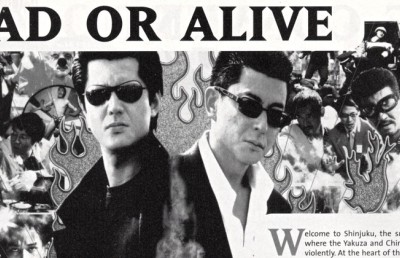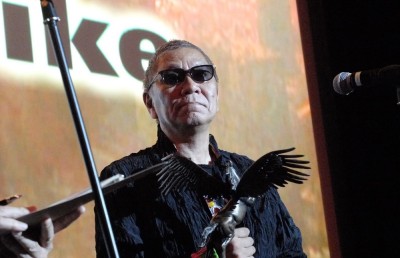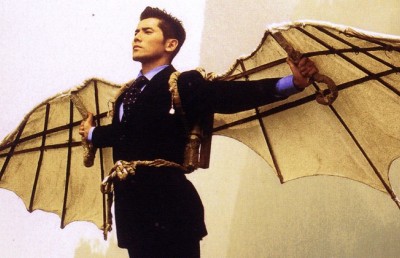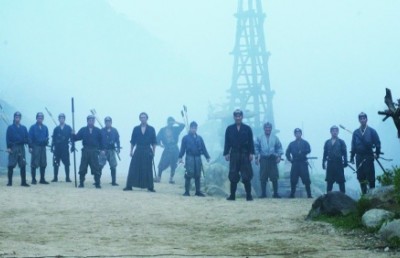Missed Calls and Shangri-Las: Revisiting 15 Years of Takashi Miike Coverage at Fantasia
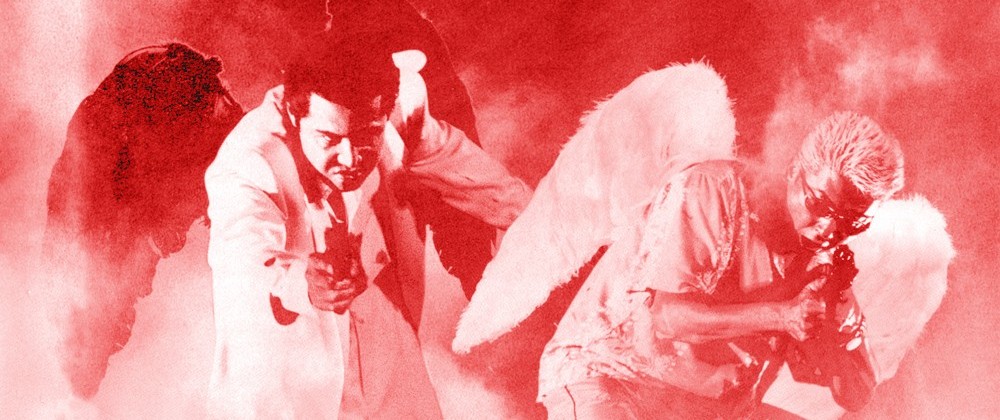
I grew up on Tony Rayns’ Asian programming for the Vancouver International Film Festival where I had been introduced to Takashi Miike through a screening in 1997, only a couple of months behind Fantasia in being the first to present Miike’s work outside of Japan. I’ll never forget Rayns himself translating unsubtitled dialogue from Miike’s first theatrical feature Shinjuku Triad Society live from the back of the room as it unspooled for the first time in front of a Western audience. And Miike himself was in attendance for screenings of Bird People in China, Rainy Dog and Blues Harp in 1998, a year ahead of any of those titles being presented at Fantasia and 18 years ahead of Miike’s first appearance in Montreal. I loved those films, particularly Bird People (see my essay on the film also in this issue), which remains one of my all-time favourite Miike outings. But these screenings provided little preparation for the onslaught of the years to come that I would experience in full force after my move to Montreal in August of 1999.
I discovered the Fantasia Film Festival by accident while walking past the Imperial Theatre during my first week in town. I picked up a program and managed to see three films at the tail end of the festival. Its spirit hooked me immediately. The next year I went as hard as I could with the $75 all-inclusive pass they had back then. Jiminny Cricket, what a deal! Too good, in fact, which is why they had to scrap it soon after. 2000 was the year that Miike became more or less synonymous with Fantasia. The festival’s international premiere of Fudoh in 1997 made a big splash, but the 1999 screening of Rainy Dog was much less sensational, so audiences would be forgiven if they were taken by surprise by the one-two punch of Dead or Alive and Audition the following year. I have scarcely experienced the level of buzz that permeated the crowd upon exiting DOA after its over-the-top finale, capitalizing on the apocalyptic angst in the months before Y2K fever and seemingly closing the doors on any possible sequels. Of course, as a director who has expressed his distaste for sequels (see our interview with Miike in this issue), the ending of DOA proved just the right challenge for Miike, ultimately delivering not one but two follow-up films. Dead or Alive 2: The Birds was the Miike film I anticipated the most over the years, and it delivered in spades, to this day my favourite of them all. And it just so happened to coincide with my first year covering the festival for Offscreen in 2001.
In this piece I revisit my coverage of Miike’s Fantasia screenings over these last 15 years, following the highs and lows that cross at the intersection of expectation and delivery, elements that have become increasingly mix-and-match as Miike continually expands his profile into new areas. It is a testament to Fantasia’s adventurous spirit that they have kept along with him for the ride leading up to his first-ever appearance at the festival to collect a lifetime achievement award. In retrospect it makes sense that I began this journey with a discussion of what has stood up as my favourite Miike film, a situation that has forced me to deal with that legacy of expectation for over a decade hence. Read on to join me on what has been a hilly ride.
2001
Dead or Alive 2: The Birds [First published September 2001

This year’s Fantasia lock was, for me, Takashi Miike’s Dead or Alive 2: The Birds. After the absolute fury and total jaw-dropping absurdity of the finale to Dead or Alive as witnessed by last year’s Fantasia audience, I had no idea what Miike could possibly come up with as a sequel. As many will remember, after taking us on a ride through the very seedy nuances of gang warfare between the Chinese Mafia, Yakuza, and a cop who’d had enough of it all, Dead or Alive ends with a confrontation of historic proportions. *(Note to those who have not yet seen it and would like to: MASSIVE SPOILERS AHEAD). Pitting one badass Yakuza against the aforementioned peace officer, the end of the film finds the two in a standoff. Having removed himself from the remains of a car that exploded with him inside, the Yakuza tears off his arm after noticing that it has been severely injured. Ready for action, he then produces a mammoth bazooka from behind his back (where it could not possibly have been hiding all this time). In response to this gesture the cop reaches into his breast pocket and reveals a glowing orb slightly otherworldly in nature. A moment passes, and then the bazooka is fired, the orb being promptly hurled in counterattack. Just before the two projectiles meet in mid-air, we are removed from the scene to a view of the Earth from space. Serene for a second, and then the whole thing just explodes. Complete annihilation. Fin.
So, with that image etched into the fibers of my brain tissue, Dead or Alive 2 opens with a shot of the Earth from space, a comet hanging peacefully over it in the blissful serenity of time standing in the stillness of cosmic grandeur. I sit patiently waiting for some recap of the destruction witnessed last year, but it is soon clear that we are not in store for a repeat of part one. The whole concept of the sequel is called into question here as over the next 96 minutes it is as if time has actually stopped somewhere in the moments just prior to the Armageddon of the film’s predecessor, treating us to a rare glimpse into the goings on between the moments that ordinarily pass in the blink of an eye.
Those seeking the all-out carnage of the first film might have been disappointed here, although Dead or Alive 2 did take first prize in the Fantasia audience awards for best Asian film. Here again the story revolves around the ongoing gang warfare between the Chinese mob and the Yakuza, and there is some excellently excessive brutality to appease the bloodthirsty. But this film also boasts a wonderful beauty and serenity that demonstrates the depth of Miike’s cinematic capabilities. In a nutshell, a hit-man staking out his target is about to fulfill his contract when, through the viewfinder of his rifle, he witnesses a stranger taking care of the job for him. Feeling that he recognizes the stranger from his youth, he tracks the man down. It turns out that they were indeed childhood friends. Both now on the run from the mob, they retreat to the island where they grew up together and there commence a journey of rediscovery. Placing their current gangster activities in the context of their childhood innocence, either lost or still intact, they decide to make a change in their lives: continue with their contract killings, but put all the proceeds towards feeding the starving children of Africa. With that they descend upon Tokyo to carry out their mission of redemption. And their descent is literal, as their newfound righteousness is made materially manifest in the form of wings that they use to swoop down on their unsuspecting targets, feathers flurrying all about; hence the birds of the film’s subtitle.
The notion of killers in the midst of lost innocence and the seeking of redemption is certainly not new to the cinema, but there is so much more to The Birds than just that. Miike’s treatment of the material is exquisite in its combination of formal brilliance, rampant brutality, genuine sweetness, and pure hilarity. This film is not in the vein of other gangster comedies where the humour is vicious and black. Although laughter is indeed prompted by the sheer extremism of some of Miike’s tactics, there is also a real touch of grace evident in the director’s hand. Those who have seen The Bird People of China will recognize Miike’s softer side, a side that can also be seen in the first half of Audition and which is very apparent in large portions of The Birds.
While the killers are in retreat on their island of childhood memories, there is a real sense of peace as they reconnect with their roots. As they retrace the geography of their past experiences, Miike inserts shots of them as children playing and going about their daily activities. When juxtaposed with the men at their present age, a poignancy arises that opens a real depth of feeling for the characters that is further enhanced when the men start reliving those lost moments in the present. It is genuinely funny and touching to see the suited men, whom we know to be hardened criminals, hosing each other down with water, swinging in the park, and playing soccer.
There are strains of Takeshi Kitano in the combination of slightly melancholic piano music (very reminiscent of the work of Kitano’s composer Joe Hisaishi) and the interplay between childhood and adulthood that Miike explores here. Kitano’s Kikujiro is probably the best example of the type of intergenerational relations I see in at work in The Birds as well. But this is not to say that Miike is ripping Kitano off; there is something deeper here about Miike’s feeling for the subject matter that makes it stand on its own, regardless of the awareness he must have of Kitano’s worldwide influence on new interpretations of the Yakuza genre.
While on the island the two assassins, in conjunction with the friend at whose house they are staying, decide to mount a play for the local children complete with full costumes and sets. The play itself is hilarious, and the interaction between the children in the audience with the staged events is also very touching. The fact that this scene is intercut with the film’s most violent episode, a raging battle between warring gang factions back in the city (involving some horrendous acts of sheer vicious rage), does not put the play in a cynical light or create a disruptive tension between the two simultaneous happenings. Miike has a way of making both scenarios appreciable for what they are. While comparisons with the famous baptism/assassination sequence in Godfather II are justified, here the extremes of juxtaposition do not play to a high moral questioning of the events. Rather, the killers are placed in their proper context, and we can see how their loss of and reconnection to the concept of youth has resulted in their present state of hiding and their subsequent decision to take control of their fates. Miike’s frequent use of juxtaposition also plays into the inevitable comparisons that will be made between this film and its predecessor, placing each in the context of the other in order to try and perceive the larger picture.
The island segment also acts as the nucleus for the sense of timelessness that permeates the film, as the line between the killers’ current lives and their childhood lives is blurred to the point where the two become one. Their time on the island is a great lull in the flow of the work, as the violence that begins the film and carries on later leaves the viewer with a sense of impending confrontation that is at its peak while in the limbo of the killer’s retreat. This limbo is the stillness of the motionless comet made manifest in the lives of the people living below. The images of the comet actually provoke laughter from time to time; there is a slight cheesiness in the way that they are more akin to still photographs than to motion pictures which makes them appear to be a cheap solution to a lack of special effects funding. However, I believe that the stillness of the comet actually suggests the fact that the journey of our heroes does, in fact, occur in a kind of pre (or post) apocalyptic state of suspension.
This timelessness can also be felt as an almost supernatural presence that permeates the space of the film. The presence is suggested from the very beginning of the film as the theme of the birds that is illustrated from time to time as a rush of indistinguishable flying creatures streaking through the dense metropolis and on into the open sky. Later, when the killers begin their righteous mission and have sprouted wings of their own, the force that was loose in the world is now contained within them. This force also allows them to transcend the confines of bodily existence. Towards the end of the film our heroes are painted into a corner with their own blood as their enemies finally catch up to them and gun them down. At this point, however, they rise and return once again to their island, drenched in blood but assuring all whom they encounter along the way that they are, indeed, fine. Stopping in on their friend, they find that his wife has just given birth and the film ends with an image of the newborn child. The words “where are you” that have appeared periodically throughout the film now give way to the words “where are you going?” and the space that the film has occupied comes to an end and our lives are now free to continue. It is as though the destruction caused by violent confrontation at the end of part one is called into question here by a larger cosmic presence, bringing the world to a halt so that two men may pinpoint their own place within that world and its turmoil before moving on to become a part of the bigger picture. That bigger picture is where the film and its protagonists are going.
The journey to that bigger picture takes place within a space where time simultaneously operates in linear and non-linear fashion. The merging of the ideas of birth, childhood, adulthood, death and afterlife are treated here non-linearly, while the narrative itself proceeds logically. The narrative logic presents us first with the men as adults, then as children, then as angels of the afterlife, then finally as adults at the end of their lives who yield to the birth of the next generation. While Miike doesn’t play with our narrative perceptions through heavy montage games like he does at the end of Audition, there is still the effect of points in time folding in on one another as the two killers make their way through the otherworldly space of an Earth in a state of suspension.
Finally, it is the larger picture of the Earth’s simultaneous fragility and stoic presence that ends Dead or Alive and which begins The Birds. Along with the holistic approach to the cycle of life that The Birds presents with its simultaneous interest in childhood, adulthood, birth, life, death, and afterlife, the macrocosmic view of the Earth in both utter destruction and the peace of stillness works to illustrate the true flight of Miike’s ambition: the search for balance in chaos, peace in turmoil, and the illustration of the fundamental interconnectedness of all things. Takashi Miike is not relegated to the use of his thumb to make his way across the galaxy; his spirit soars with the effortlessness of a bird riding the currents of millennial cinema, breathing new life into it as he goes. Fitting that The Birds ends with the image of a newborn child. There is indeed hope for the future, and I gather Dead or Alive 3 will be out next year. I trust the Fantasia crew will ensure its placement in the 2002 lineup.
__________
Sadly, DOA3 never made it to Fantasia, though I was able to catch up with it on DVD soon enough. Perhaps my least favourite of the trilogy, its challenge to the notion of “sequelism” was even more robust than DOA2, taking on multiple themes of transnational tensions in Asia from films like Rainy Dog and playing them through sci-fi elements that he would take up more regularly in the years to come and binding them through the supernatural twinges of the bird thematics in its predecessor. I had the chance to comment on it as part of a full-length essay on bird imagery in Miike’s films that I wrote as part of my coverage of Fantasia 2003.
__________
DOA Trilogy [Originally published October 2003
Miike’s better films are all genre-bending efforts at recontextualizing audience expectations. The Dead or Alive trilogy is a fascinating illustration of Miike’s desire to explore people crossing boundaries of personal, professional, and geographic territories. Much has been said about the fact that they are not truly sequels in that the stories and characters do not flow from one to the next. They simply all feature Riki Takeuchi and Show Aikawa. However, if we disregard certain expectations we have of sequels and look more closely at what goes on in these three films, they can be seen as being tied very neatly together indeed. On one level, we have the characters played by the two leads. Though not the same in name or role, they follow a trajectory in their development, literally crossing over one another, reversing roles, and finally coming together as one being – literally. The fact that this being is a bird (of sorts) says a lot.
In part one, Show Aikawa is a cop who chases Riki Takeuchi’s gangster. In part two, both men are assassins hired to kill the same man at the same time. This coincidence prompts Show to track Riki down, and ends up following him to an island which happens to be the place of their birth. Finally meeting, they realize that they are childhood friends, and spend some time reminiscing in their old stomping grounds. All this exists within an extended moment of time’s suspension. If we are to take the end of part one literally, with its apocalyptic explosion spreading across the Earth, then the second part only makes literal sense when understood as a moment in which the Earth is frozen in space. Such a frozen moment in time is indicated by the unmoving comet that hangs over the Earth throughout the film.
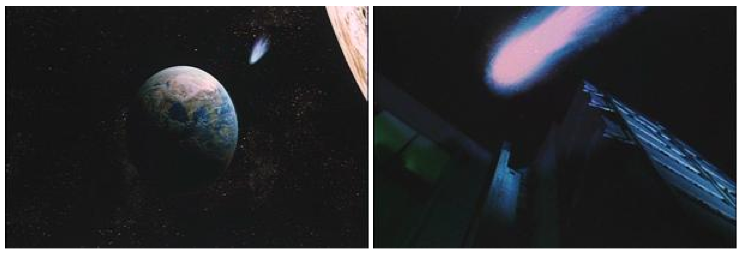
This frozen moment becomes the moment of nostalgia that allows the two men to revisit their roots, to return home in order to facilitate the major change that is to come. Putting their present lives in the context of their childhood allows them to transform these lives rather than simply regress to an earlier state. They decide to return to the world in their former capacity as mob hit-men, but all the proceeds from their work will go to feed the starving children of Africa. And so they sprout wings and take on the figure of angels out to do the world good.

However, the angel analogy is less interesting than understanding them as birds. As we have seen, birds are at the heart of the processes of change facilitated by the interaction between people and their pasts. Here they become birds as they change. When they are shot at the end of the film, they continue to exist for a period, walking the streets drenched in blood but showing no sign of being in pain. This is a moment of waking death, of the rebirth that can only take place in the face of ending life, an extension of the suspended moment that the entire film is premised upon.
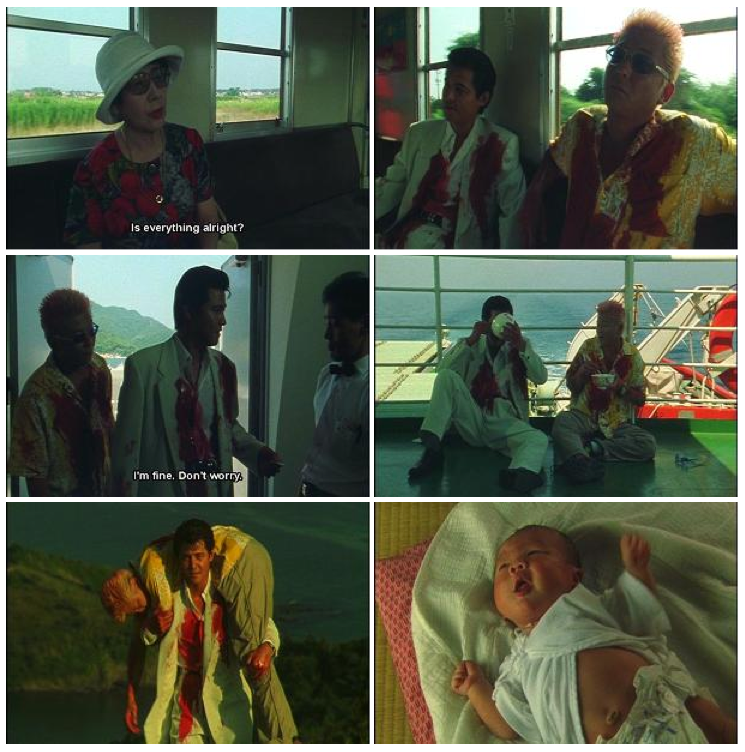
They return home once again and finally give up the ghost just as a new baby is born. Dead or Alive 2: The Birds is one of the clearest examples yet of Miike’s interest in the use of the bird as a symbol for regeneration through the cycle of birth and death, and the importance of understanding one’s own context in the world in order to facilitate change.
In part three, Dead or Alive: Final, the world resumes. The apocalypse has occurred, and Show and Riki are now replicants, which explains their existence some 300 years in the future. Only now, Show is the hunted and Riki the hunter. They have crossed over each other completely. If we look past the limits of linear narrative and understand these three films in terms of the trajectory of the interaction between Show and Riki, they work perfectly well as sequels. I suggest that, in many of Miike’s films, surface concerns (such as violence) must be looked past in order to get at their real substance, a substance which always comes down to the interaction between people involved in active recontextualization of themselves.
In this final installment, the notion of context becomes very important, and the film gets very self-conscious as a result. It begins with a projector firing up, and old movies are seen depicting scenes of humans battling great beasts of nature while a voiceover talks about the uncertainty of the future, and that the only thing that is certain is that we are alive today. A lizard monster is killed at the very moment that the voiceover speaks of life, and this ties in with the end of the film when Show and Riki have their final showdown, only to melt into one another and be reborn as a single being: a bird-like robot with a giant penis for a head. “Destruction is our source of life,” they conclude. This rebirth into the robotic penis-bird comes after a montage sequence revisiting the first two Dead or Alive films, actively seeking to put this final episode in the context of earlier interaction between the two men, and also seeking a level of self-reflexivity that began with the film’s cinema-conscious beginning.
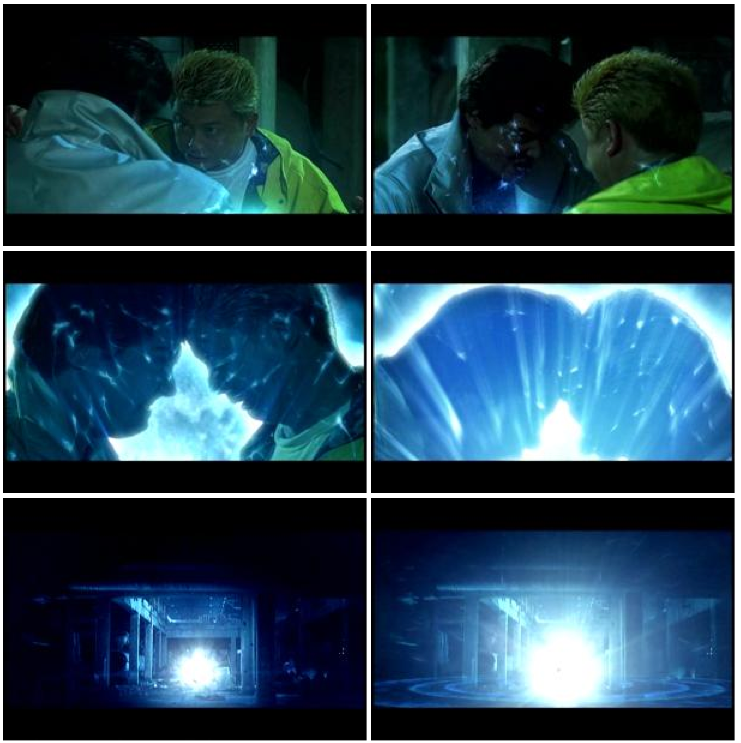
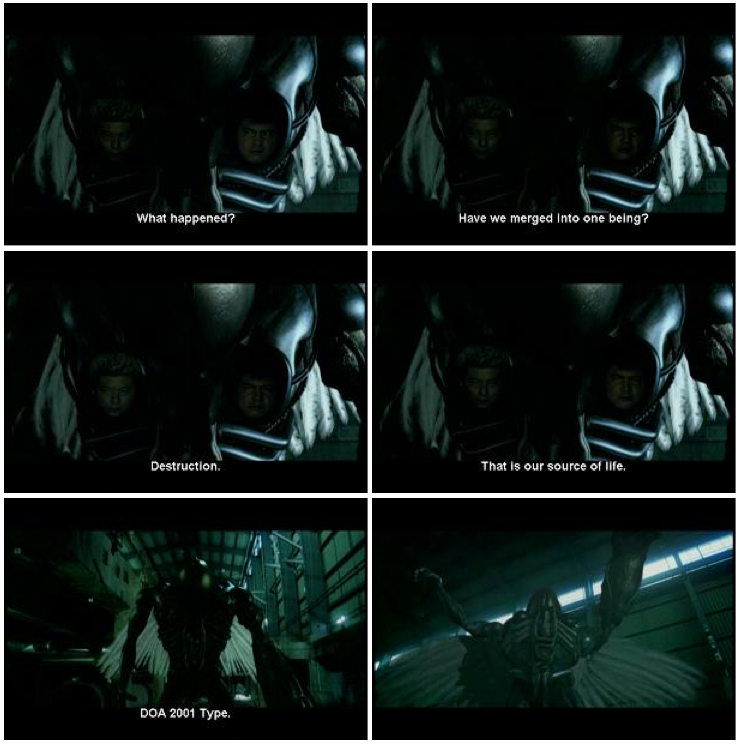
Also important for the theme of regeneration is that the future city in which Show and Riki find themselves is governed by a kingpin who demands that no babies be born into his town, and espouses the belief that true love can only exist between members of the same sex. His desire to stop the life cycle is based on his belief that overpopulation leads to the kind of war that results in the state of their present world. So, the film directly addresses an attempt at defying the natural life cycle that Miike’s characters so often seek to tap into, a life cycle that is dependent upon death as much as birth, war as much as peace. The ultimate union of Show and Riki is a confrontation with the kingpin’s abandonment of nature’s way. Riki and Show have danced a typical courtship throughout these three films, coming together and pulling away, changing roles and doing it all over again. They have been struggling with the occupation of each other’s space, and all in the context of territorial gangster feuds: men fighting men over space. Finally, they fight back against the kingpin in order to restore the option of heterosexual relationships and their role in keeping the life cycle moving, even with the potential for further war to break out as a result. This is not a condemnation of homosexuality, but a celebration of choice made possible by the inextricable bonding of two men.
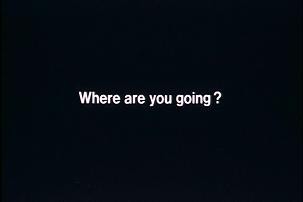
Part two ends with a shot of a newborn baby, followed by an intertitle that asks the question: “Where are you going?” In part three, we see where the world has gone: to an apocalypse where overpopulation is blamed for war, and no children are allowed to be born. But birth must come from change. Creation is the goal of the universe, and creation exists as the result of deterritorialization. These three films have explored the journey of two men on their way to change by going home again, and their continual rebirth in each film while occupying different territories clearly exhibits that oldest of clichés: the more things change, the more they stay the same. Recontextualization is at the heart of Miike’s explorations of gang warfare in the heart of nature.
2003
2003 proved nothing short of a catharsis for fans of Takashi Miike and Fantasia alike. The unthinkable had happened the year before when the festival was cancelled after relations with the ownership of the Imperial Theatre went sour. A few films originally destined for Fantasia shifted over to the “Comedia” film programming that accompanied Montreal’s world renowned Just For Laughs festival that year, including Miike’s musical The Happiness of the Katakuris. As I reported in Offscreen that year, the audiences simply didn’t come out for those screenings as they did for Fantasia proper, much as they don’t come out for the “Temps Zero” screenings in the Festival Nouveau Cinema courtesy of former Fantasia programmer Julien Fonfrède, in wich Miike’s films have appeared several times. No, Fantasia is a unique event beyond its films. It is a community that exists at a particular time, and then it is gone. We worried that this community was gone for good in 2002. Thankfully, 2003 found Fantasia newly partnered with Concordia University where it has remained to this day.
As if to make up for lost time, that year’s edition featured no less than four Miike offerings. As Fantasia’s own programming was no longer restricted to Asian fare after its first couple of years, Miike’s 2003 presence offers a cross-section of the director’s own expanding breadth. The Man in White continued Miike’s well-established tradition of Yakuza films, while Graveyard of Honor saw him tackling a remake of a classic. Ichi the Killer delivered the outrageous cinematic shenanigans that Fantasians had come to expect from previous years, while Shangri-La proved a rather light comedy that tested the limits of what might constitute a proper Fantasia film. Miike and Fantasia alike were challenging audiences with their own self-definition. And that was the year I stepped up my commitment to engaging with Miike’s work with my first feature-length essay on the director’s films, with a particular emphasis on the relationship between bird imagery and violence that including analyses of several films that had played Fantasia over the years.
I started that essay by assessing Tom Mes’ take on violence in Ichi the Killer in his newly published book-length survey on Miike’s vast output.
Ichi the Killer [Originally published October 2003
One of Fantasia’s big highlights this year was, of course, the presence of four films by Takashi Miike. And this presence was sweetened by a visit from the good people at FAB Press, who, among several new releases, had just published Tom Mes’ book Agitator: The Cinema of Takashi Miike. 1 A better venue for the promotion of this item could scarcely have been found. Agitator is the first serious study of Miike and his work, and several of us couldn’t pull out our wallets fast enough to snap it up. Going straight to the chapter on Dead or Alive 2: The Birds, I was pleased to find that the author and I are in complete agreement that this is the director’s best film to date. Appropriately enough for the festival, however, the author’s best criticism is to be found in his chapter on Ichi the Killer.
The main subject of discussion in Tom Mes’ chapter on Ichi is, as one would expect, the violence. Miike is often considered a misogynist, and this film might appear to go nowhere in terms of de-legitimizing this claim. Mes’ main point, however, is that the film seeks to confront viewers with our own consumption of screen violence, and to test our relationship to this consumption. Mes notes the dual nature of the violence represented in Ichi, one being overtly comical in its absurdity, the other being disturbing in its realism. He suggests that the violence done against men in the film falls under the comical category, and that the violence against women brings us into the realist category. Some would suggest that this adds to the view that the film is misogynistic, since we can’t take the violence against men as seriously as we can that against women. But Mes suggests that Miike’s use of women in scenes of more serious violence is a function of his desire to confront the audience with its consumption of violence, and that women make better victims because of their greater perceived fragility. The confrontation of the audience comes with the juxtaposition of the comical with the brutal, and Mes suggests that women make better representations of brutalized victims than do men. However, I really can’t see how one could avoid claims of misogyny with an approach like this, for regardless of intent to shock, Miike is still perpetuating representations of violence against women.
Interestingly, Mes notes that what we often consider to be greater realism is actually a function of what we don’t see on screen rather than what we do. Mes gives the example of the nipple-slicing scene, where the montage is such that we never actually see the blade make contact with the flesh. I would add that this is similar with the rape scenes, where punches are suggested through montage rather than being explicitly shown, and the sex is totally concealed from view. This kind of violence, Mes argues, exists within the viewer’s own imagination, and thus questions the viewer rather than the film. This is an extension of the basic principle that many horror films adopt, that being the idea that the monster is far scarier when not shown because it reveals the monsters within the minds of the audience. And as we all know, nothing is scarier than our own minds.
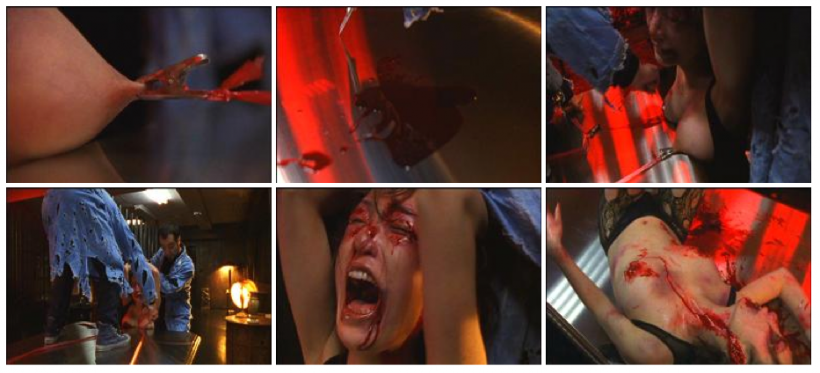
This is in stark contrast to much of the violence committed against men in the film, which features buckets of blood, guts, and splatter gore effects. The pinnacle of this overt mode of screen violence comes when Ichi slices a man vertically from head to foot, and he splits apart like a melon. Mes suggests that the function of this mode of violence is to make the audience exclaim “Wow” just before confronting us with depictions of more realist violence. By doing this, we then question why we found one kind of violence to be cool while another to be disturbing.
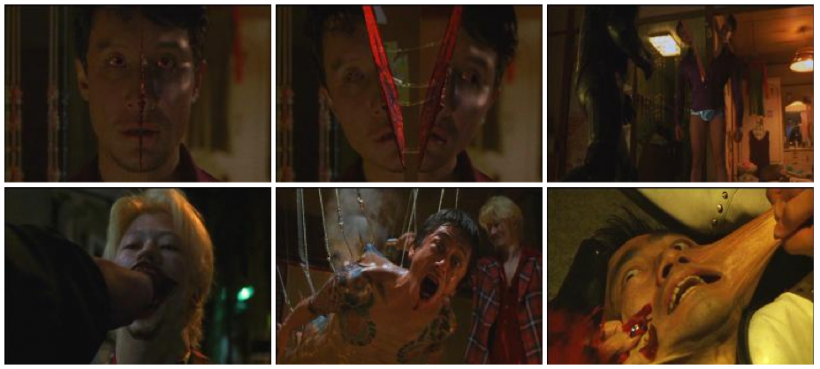
In actual fact, the Fantasia audience booed the scene where the man gets split in half, likely due to its lack of realism. So the issue becomes a bit more complex, for even in absurdly violent situations we seem to crave a measure of realism that aids in the ridiculousness. If it becomes too fake, it loses all power, even to be comical. And the man/woman distinction between the two modes of violence in the film does not stand throughout, for women are often subjected to the comical/gory style as well. The issue of misogyny thus becomes quite tangled, and I’m quite certain the Miike hasn’t given the matter the thought that we might like to credit him with. The film is a bit of a mess, and however violence is represented, there will always be the problem of “if it’s represented, it has the potential to be interpreted as glorification.” We can argue about it day and night, and we’ll never come to a conclusion. Sure, the audience’s imagination might well be conjuring up more than what is actually shown on screen. But eight decades after Eisenstein’s first explorations into the concept of synthesis, surely filmmakers are not going to blame interpretation squarely on us. Whether we see the knife slice the nipple or not, Miike’s intention is for us to believe that the nipple was sliced, so what’s the difference? The intention for the scene is that the violence be represented in the consciousness of the audience, plain and simple. There is no intended ambiguity surrounding whether or not the nipple was sliced which could call into question the audience’s thought processes.
Ultimately, though, I do think it’s far too easy to label the film exploitative and misogynist, just as it is far too easy to make a film absurdly violent under the pretense that it is supposed to confront the audience with its own desire for consumption. I think that C’est arrivé prez de chez vous (Man Bites Dog, 1992, Rémy Belvaux, André Bonzel, Benoît Poelvoorde) still holds pole position in cinema’s exploration of the audience’s relationship to screen violence, and displays an intelligence, sophistication and acute awareness of cinema that Ichi doesn’t even hold a thin candle to. Thankfully, Miike’s film has another redeeming quality which I think makes it one of his better efforts. Indeed, the ambiguity that might have made the depiction of violence more open to question has been transferred to an ambiguity surrounding the interaction of the characters involved in the violence. This ambiguity surrounding the character interactions can, in turn, come to suggest a function for violence beyond notions of audience confrontation or testing the limits of cinematic representation. What I’d like to suggest is that the violence in Ichi and so many other of Miike’s films might best be understood as the soil in which much deeper concerns about relationships between the past and the present are played out in the lives of characters involved in physical interaction with one another. Finally, Miike’s films are about death and rebirth, suicide and regeneration, and as such, have found a fine environment here at Fantasia 2003 [following the festival’s own rebirth in its new home at Concordia].
2004
2003 was something of a peak year for Miike at Fantasia, and was exhausting as such. Expectations were established and met, while hints of future disappointments peeked out from behind the curtain. In the following years my coverage would focus on audience expectations in the face of Miike’s increasingly erratic path away from the staples of his first decade, and the density of the interplay between satisfaction and frustration that would become the hallmark of the prolific filmmaker’s outings in the heat of many Montreal summers to come. In retrospect, Deadly Outlaw Rekka served as obituary to the Miike of the Yakuza 90s and a call to arms for those that dared follow him to new arenas. All the more appropriate that this was also the year that Miike played a Yakuza on the hunt in Pen-Ek Ratanaruang’s excellent Last Life in the Universe, winner of this year’s Jury Prize for Best Overall Fantasia Film.
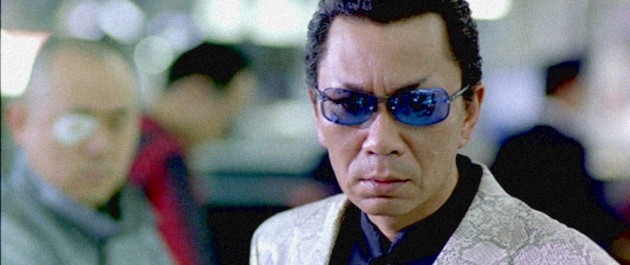
Takashi Miike as Yakuza on the hunt in Last Life in the Universe.
Deadly Outlaw Rekka [Originally published September 2005
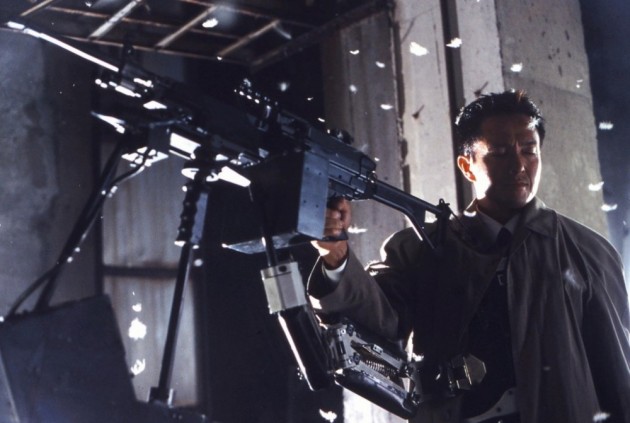
When Takashi Miike’s Deadly Outlaw Rekka (2002) came to Fantasia [in 2004], there was a level of expectation so palpable in the Hall auditorium that I thought people were going to lose their minds. For fans eager to jump into more Ichi the Killer fare, Rekka turned out to be one of Miike’s more frustrating outings. Despite periodic outbursts of heavy action scored with highly charged prog rock from Japan’s Flower Travellin’ Band, Rekka was deliberately slow. You could hear the tension building in the room as little moments caused isolated outbursts of laughter from one or two people while the rest rustled nervously wondering if this screening was going to deliver or not. 2003 had seen massive walkouts during Miike’s Man in White (2003), another very slow offering – which also happened to be two and a half hours long and which started a half hour late. Not so many walkouts for Rekka, but a really weird energy filled the space until, at long last, Riki Takeuchi donned a shoulder-mounted rocket launcher and started laying waste to various large buildings.
Not quite the finale boasted by Dead or Alive (1999), but enough of a release to turn the evening from an exercise in tantric restraint to good ol’ fashioned climactic release; all the more appropriate for a film which inspired more pregnant silences than I’ve heard in a while.
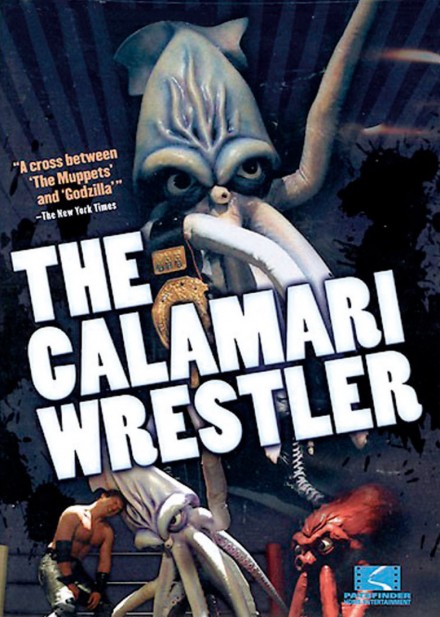
Interlude
With over a decade’s reflection I now appreciate Rekka as one of Miike’s last forays into the Yakuza genre before shifting the compass for increasingly new territories in the years to come. And for introducing me to Flower Travellin’ Band. The power of Miike’s deployment of their Satori album in Rekka prompted me to seek out an original Japanese pressing on ebay shortly thereafter, which remains to this day the most expensive slab of vinyl in my collection. When news broke that Miike would finally grace Fantasia with his presence in 2016 I quickly settled on that album as the object I’d most like him to grace with his autograph. It’s rare that a filmmaker makes such an imprint on an audience with the use of pre-existing music. David Lynch, Quentin Tarantino and Sofia Coppola come to mind. While I wouldn’t put Miike on the same level of finesse with compilation soundtracks, I could scarcely think of a more badass autograph than to get Miike to sign my copy of Satori. It took me three encounters with Miike to get the job done, and it almost didn’t happen. I brought the album with me to our private interview on Friday, but with only a meager 20 minutes allotted for our meeting, and a full-day of interviews scheduled, the press coordinator insisted that there wasn’t time. So I brought it with me to the screening of As the Gods Will on Saturday, but when I pulled it out while in line for a post-screening photo-op I was told that Miike’s contract stipulated no signings allowed. I was pissed off, but not entirely discouraged. I brought it down again on Sunday for the screening of Terraformars, determined to catch the director smoking on the street or perhaps exiting the bathroom. That didn’t happen, but after the film they announced that he would, at long last, be doing a signing in the lobby. And he looked suitably impressed when I pulled it out amidst everyone else’s DVDs and the occasional copy of Tom Mes’ books.
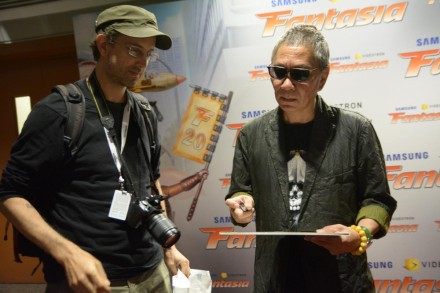
Photo Credit: King-wei Chu
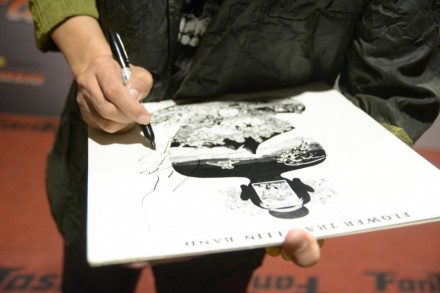
Photo Credit: King-wei Chu
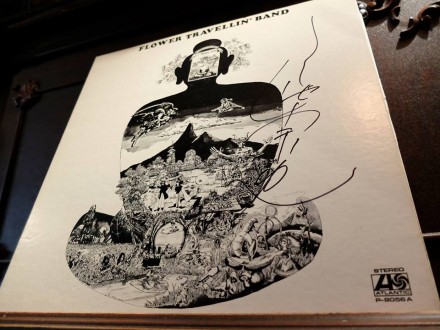
2005
For the first time since 1999, Fantasia featured only one feature length Miike film this year, but it was a doozy.
Izo [Originally published September 2005
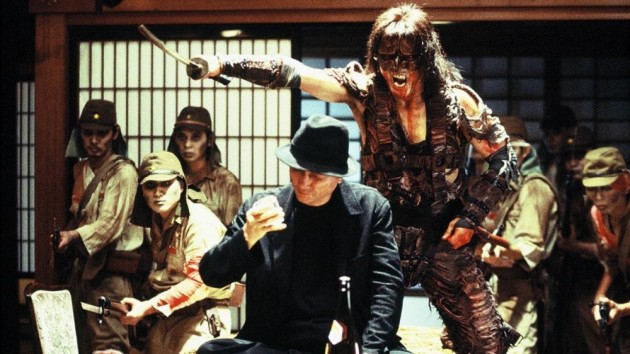
Izo, a somewhat bizarre outing in which a violent warrior travels across generations to exact his revenge on those that killed him so long ago. Doesn’t make sense? Doesn’t matter. This is a film which takes the inextricable link between birth and death so much for granted that it presents Izo as a constant across both planes, dolling out death as he is constantly reborn. The film isn’t really like anything I’ve seen from Miike before. The violence is not that of Yakuza warfare, nor of noble Samurai battle. It’s almost inexplicable in its constancy; it seems to be the film’s sole reason for being, despite musical interludes from folk singer/guitarist Kazuki Tomokawa (somewhat reminiscent of The Life Aquatic with Steve Zissou (Wes Anderson, 2004). Izo presents a world in which everyone fears the coming of the warrior, but in which the warrior himself embodies the reason why such fear is unnecessary. Nobody can escape death. And from this film’s perspective, it would seem that nobody can escape rebirth either. I’m not sure if I enjoyed the experience, and I’m a rather dedicated Miike fan. But for those interested in his work I suggest that this one is required viewing. I’m glad I fulfilled the requirement in the context of its Hall auditorium screening. Like last year’s Rekka there were pregnant silences aplenty; I dare say the audience didn’t know what to make of this one. The highlight moment of my festival came when, upon the completion of Kazuki Tomokawa’s longest number there was a beautiful pause in which an audience member behind me was heard to exclaim “Un autre!” That’s my general feeling towards Miike: you keep makin’ ‘em and I’ll keep watchin’ ‘em. And I trust that Fantasia will keep bookin’ ‘em to ensure that we can all watch them in the best environment possible.
2008
Alas, as the years progressed, I found myself increasingly fatigued by a commitment to Miike that wasn’t rewarded by the kind of work upon which that commitment was founded. Of course this is my own problem, stuck as I have been in my revelry upon his first decade. I have appreciated the fact that he moved steadily away from Yakuza fare and into other realms, including films for children, TV episodes, remakes, homages, comedies and even romance. It is laudable that Fantasia has kept with him across these adventures, but the excitement in the room has palpably dwindled over the years. Of course there are always exceptions, like that time Tarantino played a cowboy in Miike’s western…
Sukiyaki Western Django [Originally published November 2008
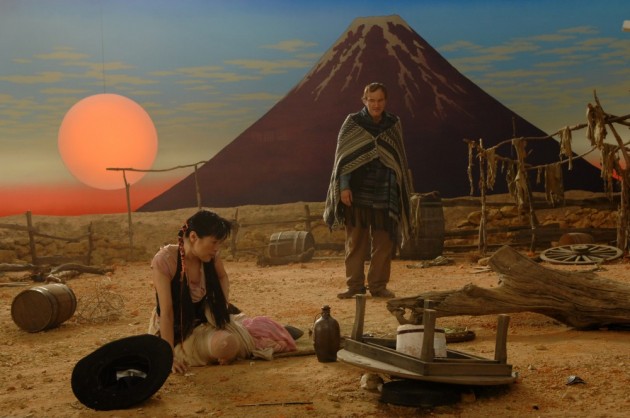
As something of a Miike aficionado, I am always up for discovering new avenues traveled by this unusually prolific director. Here we find Quentin Tarantino opening the film on a superbly cheesy desert set, featuring a deliberately cardboard Mt. Fuji backdrop flanked by a big orange sun hanging on a string. Tarantino acts as the film’s narrator, of sorts, introducing the back-story before the film sets off in a more realist manner. Later in the film we find Tarantino again, now an old man inserted as a character within the narrative proper. At one point he announces that he has always been a die-hard otaku at heart, causing an uproar of enthusiastic screaming and applause from the packed audience to rival any Fantasia response I’ve experienced to date. This moment was the perfect embodiment of the Fantasia experience. A line of empathy opens up between Tarantino and the audience as he is positioned as a fan-boy living out his dream of being in one of his idol’s films, just as many in the audience might dream of being in a Tarantino film. And so Tarantino becomes a member of the Fantasia audience, enabling a kind of transmogrification that can be read through Tarantino’s own films as he increasingly defines his work around practices of fandom through his cinematic homages to all the genres and styles that have influenced him over the years. And this street seems to go two ways, with Miike himself demonstrating his own love of Tarantino by embedding him within his latest outing, itself an homage to the Western genre that so fascinated Tarantino in Kill Bill Vol. 2. This moment acts as the nexus point of a kind of incestuous vicious circle in which the line between creation and influence is almost completely dissolved, and Tarantino’s otaku line invites the audience over the threshold to take part in the orgy. I’m surprised the whole room didn’t implode leaving a black hole in its wake to suck any remaining onlookers into its crushing vortex. Maybe then the administration would finally have to change the horrible seats in the Hall Theatre.
2010
Sukiyaki Western Django was the last time at a Miike screening that I felt anything close to the audience buzz that regularly accompanied his Fantasia screenings in earlier days, a sentiment I carried through to my review of his entry in the Crows franchise that screened two years later.
Crows Zero: 2 [Originally published May 2011
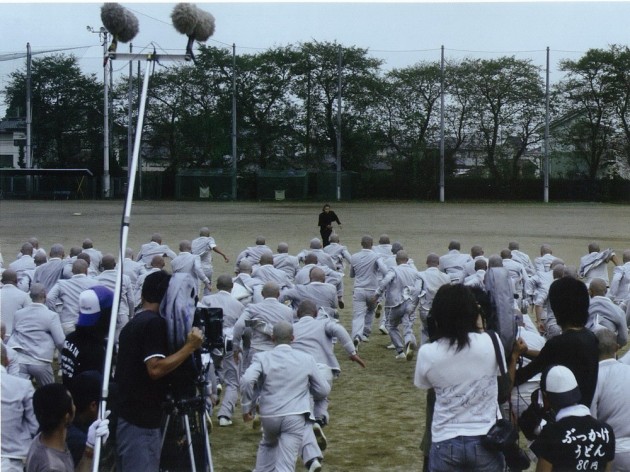
As with every year, my expectations for the mandatory Takashi Miike entry/ies ran high, although his recent offerings have not matched the heyday of the early 2000s when he blew the doors off of the Imperial theatre with Audition, Dead or Alive parts 1 and 2, and Visitor Q. But I just can’t help but think that through his Fassbinder-like production pace there ought to be gems emerging on a regular basis. But truth be told, Big Bang Love was the last of his films to catch my interest, hoping that its dramatic stylistic turn from anything he had previously done was a herald of great things to come. Sadly, we have yet to see any direct descendants from that film, most of his recent work following predictable trends in his fetish for gangster fare or his increasing work with studio franchise installments. And the latter was the case with this year’s entry Crows Zero: 2, a sequel to a prequel based on the popular manga. My spirits were raised a bit when the film started with beautiful shots of crows descending on a pier, extending a major recurring interest in bird imagery that I analyzed in my report on Miike’s films at Fantasia 2003. Here the crows land next to the gang leader around which the film revolves, and we are given some words to place the bird imagery in context: These are the crows. They don’t flock together easily, but it is better to be a crow flying free than a bird in a cage. And that just about ends any overt references to the animal kingdom and the story of gang conflict takes over in earnest. There are some nice flourishes here and there, like the image of a hole melting through the film opening up during a crane shot booming up from the body of a rival gang leader dead in the street. And throughout the film there is a visceral energy and raw quality that is very Miike indeed. But franchise necessities, like a string of J-pop performances running throughout, relegate the film to more of a vehicle for product-placement than cinematic experimentation. And at 133 minutes the film is about an hour too long.
Interlude
The blurbists tend to play up the auteurist angle when writing about Miike, suggesting that his personal flair is always in evidence across his genre-hopping leaps between independent and studio work. But I think there’s a strong case to be made for Miike as a kind of anti-auteur, an “agitator” (to borrow Tom Mes’ appropriation of a Miike film title for his book on the director) who provokes by way of frustrating expectation at every turn. But this frustration of expectation gives every Miike screening a special flair; in the end, you really never know what you’re going to get with him, a situation bound to keep you on the edge of your seat regardless of how the films turn out.
On this front, post-2005 Miike might prove the most interesting in the long run, a period with complexities and paradoxes well articulated in Tom Mes’ second book on Miike, Re-Agitator: A Decade of Writing on Takashi Miike, in which the author collects assorted coverage on the filmmaker into one volume (which, I will admit, inspired my approach to the piece you’re reading right now). As I wrote in my review of the book in 2013:
Re-Agitator: A Decade of Writing on Takashi Miike [Originally published May 2013
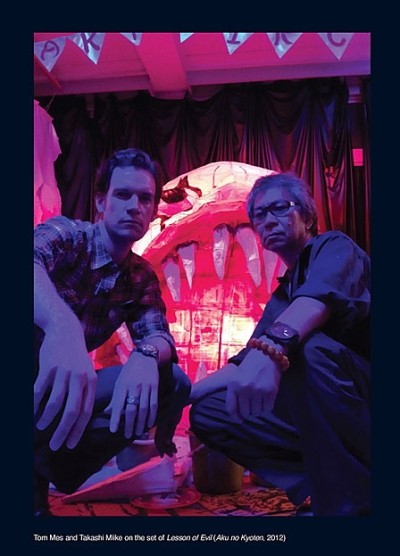
The book shines best in its coverage of the mid to late 2000s, the most interesting period in Miike’s career for me, the moment when it seemed that the director’s shift to larger budget studio fare was paralleled with an increasingly experimental bent. For every One Missed Call, Zebraman or Crows Zero there was a Gozu, Izo or Big Bang Love: Juvenile A. Readers of my regular Offscreen coverage of Miike’s entries in the Fantasia Film Festival know that this was the last period that I have been able to get excited about Miike’s work, an increasing sense of uncertainty fueling anticipation as audiences who saw 3 or 4 new Miike films each summer experienced the paradoxical simultaneity of his work in this era. Mes deals admirably with material that is arguably Miike’s most difficult to grasp, and has some fascinating stories along the way. Particularly exciting is his insider coverage of Miike’s first trip to Cannes with Gozu, his direct-to-video transition out of the Yakuza era that somehow found its way into the festival’s director’s fortnight. Mes reports on Miike’s pleasure at discovering that a film he thought would be lost to non-Japanese audiences could be appreciated at such a festival as Cannes. The book’s interview with Miike was conducted during this period of heightened experimentation and Mes questions him about his intentions to continue in this vein. As you would expect, Miike brushes the apparent trend off by saying that he doesn’t have a specific preference for the kind of work he takes on, and would be happy simply to continue being offered a diverse range of projects (60-63). Sadly, it would seem the opportunities to experiment have dried up and we are left now with a predominantly industrial Miike.
I must admit that I am one of those early fans now “grumbling from the terraces of late about the recent state of one Takashi Miike” (123). Why can’t we have the Miike that once was? Or at least one that continues to stimulate in the same way? Mes’ answer lies in his unpacking of the industrial realities in which Miike works. If there is one overreaching argument in Re-Agitator it is that Miike is alive and well, continuing to be himself, putting his own spin on whatever material is available for him to direct. “It is not Takashi Miike that has changed, but the industry around him” (123). But this argument is not entirely satisfying to me, especially since one of the justifications for this book is Mes’ emphasis on how his own personal changes over the last ten years have affected his criticism. Mes’ suggestion that Miike hasn’t similarly changed seems overstated, but never mind. Regardless of the extent to which Miike’s own personal changes have interacted with the industrial shifts that surround him, I haven’t as of yet appreciated the newer Miike to the same extent as various former incarnations. Yet in the end Mes says it best: “To wish for Miike to go back to cranking out Dead or Alives and Auditions on a bi-monthly basis is like wishing for tomatoes to still taste the way they did before your country joined the European Union – that era, I’m afraid, has passed” (123). And it is to Mes’ great credit that the insight he provides into Miike’s later work is prompting me to revisit some of the films that I didn’t care for on first viewing, seek out a few that I’ve missed over the years, and go into the new stuff with an open mind. Just as I was feeling okay about leaving the tomatoes off my salad altogether, Re-Agitator comes along and kindles my desire to give the new breed a fair shake.
2013
As though in recognition of my renewed acceptance of Miike’s work over the years, Fantasia 2013 featured A Lesson of the Evil, something of a throwback to a decade past and easily my favourite Miike since Big Bang Love. It spurred me to write a feature-length essay on it alone, which began with a contextualization of this bit of Miike nostalgia within Fantasia’s own return to times past at the Imperial Theatre.
A Lesson of the Evil [Originally published May 2014
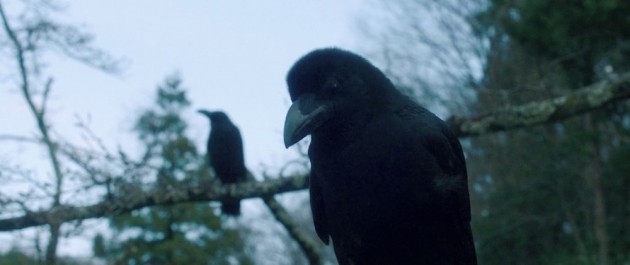
For the first time in 10 years Fantasia has returned to the legendary Imperial Theatre, site of the festival’s birth and home to its first six years. When relations with the Imperial’s management went sour in 2002, Fantasia was cancelled for that year. After defibrillation we all picked ourselves up off of the floor and brooded over what felt like the end of an era. Then the news came that the festival would return for 2003 at a new venue: Concordia University. Prepared for the worst, I was pleasantly surprised at how well it worked (see my 2003 coverage of the transition here), and we haven’t looked back since. Until now, when delayed renovations to the Hall Theatre forced a new temporary venue for 2013. The Imperial was once again available, and it was a homecoming to be sure. But the return also underlined the fact that you can never really go home once you’ve been gone for a decade. The Imperial is fabulous, but something of the vibe of those early Fantasia years was missing, as though the festival’s animating spirits have ceased their haunt of the Imperial’s baroque ornamentation and floated down de Maisonneuve boulevard to take up residence between the slats of the Hall Theatre’s wood-paneled wings. Perhaps these spirits are made manifest through a venue’s gradual seasoning over years of exposure to the world-famous enthusiasm of Fantasia’s audiences; hopefully they aren’t living in the Hall Theatre’s battered old seat cushions, to be replaced at long last in time for the festival’s return to Concordia in 2014.
Despite the missing je ne sais quois, the festival’s setting this year proved the ideal context in which to contemplate Takashi Miike’s Lesson of the Evil, the first Miike film to really excite me since his millennial heyday. The film has been touted as a welcome return to the prolific director’s exploitation roots. Indeed, the film delivers the buckets of blood that Ichi-heads have been craving since Miike’s departure from the staples of his early gangster fare and subsequent horror crossovers. Another homecoming, of sorts, after Miike’s decade on the lam since bending his beloved gangster genre so far out of shape with Gozu that there was nowhere left to run but away. Far, far away. As Tom Mes charts in his excellent collection of essays on the director’s output over the last ten years (reviewed here), the diversity of Miike’s more recent projects has been dictated, in large part, by the ebbs and flows of industry: Japanese producers have moved away from the video market that made Miike’s early work possible and into the area of highly commercial theatrical cinema. That Miike has been able to keep working through these shifts is a major feat. His adaptability in this regard may prove to be his most characteristic trait in the end. But those of us whose enthusiasm for Miike’s work has waned along with these changes can’t help but hope for glimpses of the filmmaker we once knew. Though it’s pure happenstance that Miike’s shift away from his turn of the century staples has paralleled Fantasia’s change in venue, this makes it all the more fitting that Lesson of the Evil’s return to form just happened to coincide with Fantasia’s return home to the Imperial.
But Lesson of the Evil offers much more than blood spatter. I took my seat in the theatre expecting disappointment, a feeling reinforced a few days earlier when the festival opened with Miike’s dull police procedural Shield of Straw. But it didn’t take long for my mood to change once the lights went down and Lesson of the Evil settled into the slow burn of its first hour. Traces of Audition’s emotional tension and Gozu’s oddball supernatural flourishes were tantalizing, but what got me most excited was the film’s most thematically integrated use of bird imagery since Dead or Alive 2. Ten years ago I wrote at length about the significance of bird imagery in Miike’s work to date, and have long planned a follow-up – only to be continually thwarted by the lack of significant development of the motif in Miike’s later work (the biggest letdown being Crows Zero, which had zero to do with crows). When Miike engages with these creatures substantially, they peak his cinematic imagination in ways that are absent from a lot of his work – particularly of late. I think Miike is at his best when he is able to lift the genre fare with which he is charged out of its bounded constraints and into another plane. For a time, the motif of birds allowed him to do just that. They frequently offer pause to reflect upon the action of the film from a different vantage point, occasionally lifting that action to another realm altogether. I once waxed philosophical about the role of birds in his films as agents of “de-territorializing” flight (after Deleuze and Guattari’s A Thousand Plateaus), a good enough analogy for the paths that birds have traced out of the boxes within which Miike has spent his career working. But the birds haven’t flown as they once did, their wings clipped as Miike himself took flight into the new domains of Japan’s shifting film industry. In this regard Lesson of the Evil marks something of a “re-territorialization” while exploring the roots of this territory more deeply than ever before. Simply put, Lesson of the Evil is the best Miike film since Big Bang Love promised an avant-garde turn that never quite materialized. Or perhaps it would be better to say that Lesson of the Evil will get you halfway there.
__________
After an in-depth analysis of the film’s most thorough integration of the bird motif since the DOA trilogy, I hung my appreciation on the film as an apparent set-up for full deployment in a sequel promised by the “To Be Continued” title card that closed the film. Now nearly five years after its release, such a sequel is drifting into the realm of fantasy. These were my concluding thoughts on how the film holds up if it is to be a stand-alone in the end:
__________
If the film is to be the only Miike entry in the Lesson of the Evil franchise, then it leaves something to be desired. It’s not without social critique, speaking to the stress of Japan’s high-school system, suicide rates highest as students crack under the pressure of the exit exams that can have a profound effect on their immediate futures once released to the world outside. The fact that Hasumi frames all his murders as suicides can be read as stringent commentary on a major social issue that needs to be addressed, shifting attention away from those who take their own lives to the environments and relationship dynamics that breed the impulse to self-destruct. And the film explores these issues through its rich interplay between aesthetic, narrative and thematic treatments of surveillance. Yet this doesn’t seem enough to warrant the excess, which would be better situated as a centerpiece to a larger project than the conclusion to a single film.
So where will this go? Fantasia returns to Concordia’s newly renovated Hall Theatre for the 2014 edition where it will remain indefinitely. To indulge in some questionable hermeneutics, since Miike’s films have not been as interesting since Fantasia left the Imperial, then perhaps a theatrical follow-up is doomed to disappoint if it plays at Concordia in the years to come. Or perhaps, speaking from a more grounded position, it could be that my enjoyment of Lesson of the Evil was premised a bit too much on experiencing it in the context of nostalgia for the Fantasia of the Imperial Theatre. Maybe, in the end, the film is more interesting without a conclusion, the moment of anticipation more satisfying than any possible resolution. Regardless, it was great to find Miike back in bird country as Fantasia re-visited the site of the festival’s birth amidst the waning energy the venue absorbed during those early Miike screenings that launched the maverick director onto the consciousness of North American audiences. For a moment I felt back home, but that can never last. That the film didn’t finish what it started is, perhaps, icing on a cake we’ll never get to eat.
2016
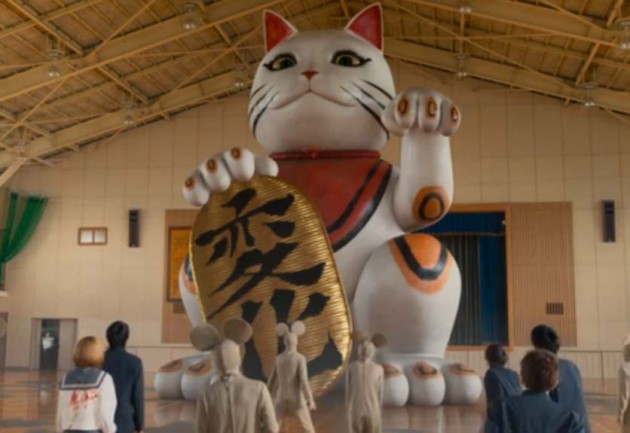
This year, at long last, Miike walked among us here at Fantasia along with two new feature films, As the Gods Will and Terraformars, and a surprise animated short, Keep On Rollin’! It was a true homecoming for the director who has screened more work at Fantasia than any other in the history of the festival. You can read our coverage of his time in Montreal, with some discussion of his new films, here.
Notes
- Mes, Tom. Agitator: The Cinema of Takashi Miike. Godalming: FAB Press, 2003. ↩



